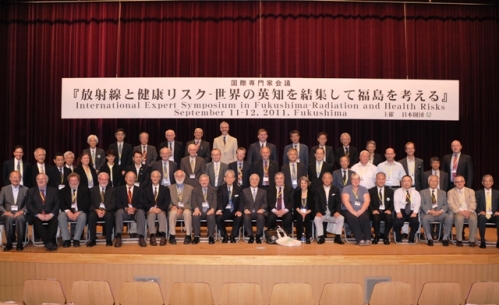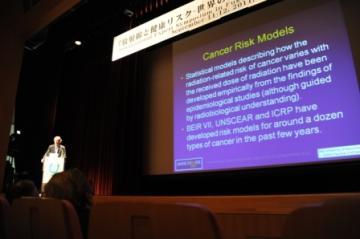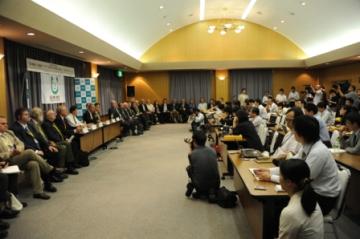International Expert Symposium in Fukushima
Radiation and Health Risk

On September 11th and 12th, at Fukushima Medical University, more than 40 of the world’s top experts in the field of radiation and health gathered to discuss the health effects of fallout from the meltdown of the Fukushima Daiichi Nuclear Power Station. Over the course of the two days, they discussed the issue, at the end producing an eight-point set of conclusions and recommendations that among other things outlined the importance of continued monitoring, and suggested the establishment of a taskforce on the issue, which would include all stakeholders.
Background:

In Japan, March 11, 2011 is a day that will be remembered for generations. On that day, an earthquake of 9.0 on the Richter scale struck the northeast, generating a tidal wave that utterly flattened villages throughout the region. One casualty of the disaster was the Fukushima Daiichi Nuclear Power Station, which was hit hard enough to cause multiple explosions and meltdowns in three of the station’s six reactors. In the days following the disaster, northwesterly winds and precipitation brought a good deal of the radioactive particles to ground within the prefecture. Since then, the public has been extremely worried about the effects of the radiation.
At the root of the worry has been a lack of coherent information regarding the radioactivity. Voices from the government, from individual commentators, from scientists, and from activist groups have all been saying different things. While not everything published has been accurate, most people actually know very little about radiation, and so these conflicting opinions have done nothing but fan the fears of the Japanese people.
Twenty five years ago, these same fears were visited on people in Ukraine, Belarus and Russia following the 1986 Chernobyl explosion. In the wake of that accident, The Nippon Foundation spent 10 years conducting a medical survey of more than 200,000 people who had been children when it happened. In the course of that project–which went a long way toward calming the fears of local residents–the organizers were able to develop contacts with the top people in the field of radiation and health.
Thus, as part of its effort to help Northeastern Japan revitalize itself after the quake, the Foundation decided to draw on this network, bringing those experts to Fukushima, so that they could take stock of the situation, debate its dangers, and hopefully offer something of a way forward.
“International Expert Symposium:”

On September 11-12, at Fukushima Medical University, these experts came together for the “International Expert Symposium in Fukushima – Radiation and Health Risks.” While all hailed from the top radiation- and cancer-related institutions in the world, including the IAEA, WHO and ICRP, each had slightly different expertise, making for a truly interesting two days, during which everyone was able to learn from everyone else. Topics discussed ranged from the conditions under which the fallout occurred, to the reality of just what risks are involved in exposure to radiation, and suggestions for how to protect people in contaminated areas. (See Program)
Questions following the presentations were incisive, demanding the highest level of expertise and honesty from the presenters. No one could forget for an instant that they were speaking, not only before some 400 other scientists and doctors, but in front of thousands of people who watched on their computers via a live Ustream feed , and indeed, through the media, to the entire Japanese nation.
Following the symposium, the group of more than 30, lead by foundation Chairman Yohei Sasakawa, gathered for a press conference. Questions were direct and aggressive, given the importance of the issue and the lack of trust that the press and public had come to feel toward those running the meltdown control effort. In response to this, Sasakawa stopped the Q & A momentarily and told the reporters, “We need for you to understand what we are saying. So we are going to stay here, answering your questions, until you have no more.” The conference continued for three hours until even the angriest of reporters was satisfied with the explanations given.
Conclusion
It is supposed to be impossible to bring 30 experts of any kind together for a discussion, and achieve a consensus. And yet this is what happened at the symposium on Radiation and Health Risks. The Conclusions and Recommendations were compiled and agreed upon in a startling short time, and with no real wrangling over the core safety issues. Their findings, and other related documents can be found below.



